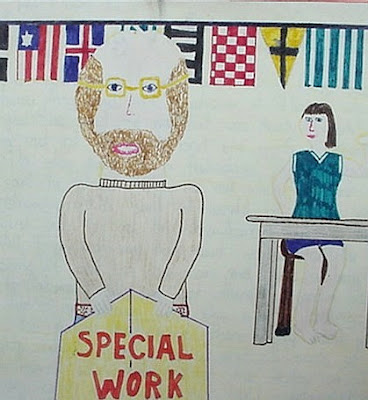
Sharon, a gifted writer and artist, begins her personal experience book with a portrait of her teacher in 1976. I still meet up with Sharon regularly -she now has her own children at a local primary school.
Developing a student centred inquiry classroom
Prologue
During a recent cleanout I came across of a diary I wrote when I began my teaching career in New Zealand in 1976 although I had previously taught in the UK in the late 60s.
Nothing unusual about this but for me it was a major shift in my career since 1961 I had been an adviser in school science and my ‘teaching’ had been limited to assisting teachers in my province with their science programmes. This entailed taking classes on environmental studies of the bush, streams, the mountain, the rocky shore and the immediate locality as well as helping them with physical science topics.
During this time I was lucky enough to be able to visit the classrooms of innovative teachers, mostly in smaller rural schools, who were developing integrated programmes to replace lessons take at set times. Also at this time, along with a number of local teachers, I had become aware of the UK Nuffield Junior Science approach where classrooms followed up more than one open ended studies at any one time. We were also aware of ‘child centred’ primary schools in the UK (the ‘Plowden approach’) and also the ‘open education’ classrooms from the US. Perhaps, though, the biggest influence on ‘our’ teaching was the work of Elwyn Richardson through his book ‘In the Early World’. Elwyn’s work was associated with the related arts approach encouraged by the art advisers of the day and many local teachers implemented similar programmes.
They were exciting times.
Following my year teaching in a progressive primary school in 1969 I was determined to introduce similar ideas in local selected schools. This was to be the beginning of what was to be called the ‘Taranaki Environmental Approach’ – largely based on students exploring their immediate environment through an integrated approach.
After the success of teachers involved I was keen to teach in classroom to try things out for myself. As mentioned this was to be a major shift as I had (except for one year in the UK) never been a classroom teacher. With this in mind I was determined to keep a diary of my experience and it is this diary I now wish to return to for a number of reasons.
First to put into practice ideas I happy shared with others. All adviser should be prepared to put into action ideas they think others should action. To this day this is very important as it is all too easy to tell others what to do but, unless the advisers have practical experience, their ideas will always have an element of disbelief about them.
Secondly, after reading my diary, it is important to share what might now be called ‘personalized learning’ where real student inquiries underpin the class programme.
Thirdly, to draw attention to the difficulty and confusion involved in introducing any major shift in the teaching/learning approach. Any real classroom change involves uncertainty and second thoughts and, if this is not acknowledged, teachers who find new programmes difficult are all too likely to blame themselves. It is too easy for successful teacher to romanticize their experiences (glossing over their difficulties) or to suggest it is simply a matter of following some basic procedures and all will be well. It is even more problematic when advisers are ‘delivering’ ‘best practice’ ideas that they have never implemented themselves; a situation which is all too often the case today. This lack of recognition of the emotional pressures involved and the doubts that surface when introducing new ideas leads to most of these ideas not being sustained. People who introduce new ideas into schools have forgotten that teachers learn best from their fellow teachers and not from distant experts often far removed from the reality of the classroom. The recognition of the expertise that lies within the teaching profession is a vital antidote to all the advice ‘delivered’ from outside the school no matter how well researched and packaged.
It is important in this new millennium that teacher expertise be recognized as integral to any lasting change.
Finally, after reading my diary notes, I believe the ideas that ‘we’ developed in ‘our’ classroom in those days contribute to the directions now being espoused by the ‘new’ New Zealand Curriculum. Like the NZC we believed that all students should develop the capacities to become ‘confident life long learner’ …’able to seek use and create their own knowledge’ and to have all their gifts and talents recognized; that all children have the opportunity develop positive learning identities.
The best thing is that we now know far more about how children learn today and, if we put them into practice, no student need fail.
Next blog. Did I make the wrong decision – uncertain beginnings?
3 comments:
Look foward to the next up date.And I agree -advisers should return to classrooms regularly to keep in touch wth reality and to appreciate the pressures of being a teacher. Advice is easy - putting it into practice is the hard part!
Next entry a bit slow in coming Bruce!! Your commnent about those who 'tell' ( or 'deliver') returning to teaching is pertinent!
Yes - education is full of academic 'experts' who have lost touch with the reality of the classroom - they keep passing down 'one size fits all' directions. The further away they are the more confident they sound with their 'best practice' and 'evidence based' mantras.
I would put ten creative teachers against any ten hand picked 'experts' anyday.
Post a Comment